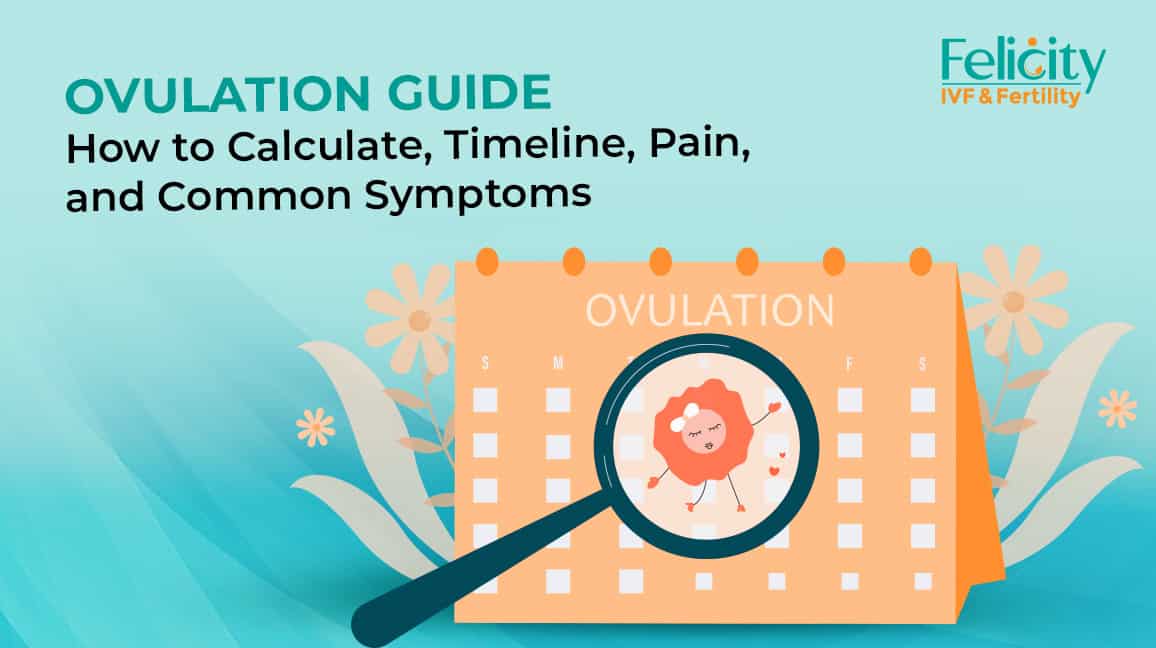Ovulation Guide: How to Calculate, Timeline, Pain, and Common Symptoms

Knowing your reproductive cycle is a nerve-racker, as it happens, even when you are not attempting to conceive, just to get to know yourself and your reproductive health better. The core of this is the ovulation cycle. Although most individuals are conversant with the aspect, what ovulation entails and ways of monitoring it can be a confusing aspect. This one is intended to make the topic clearer to you, as we are going to explain the signs of the ovulation process, its schedule, and the most important things you need to monitor in the easiest possible way. In the end, you will know more about your body and how amazing it changes every month.
What is Ovulation?
The menstrual cycle is comprised of many phases, and ovulation is one of them and happens when one of your ovaries releases a mature egg. The egg is then transferred through the fallopian tube, where fertilisation of the egg can occur by the sperm. Assuming that the fertilisation fails within 12 to 24 hours, the egg decomposes and the uterus lining is discarded, which results in your period. The whole process is a hormonal ballet, with the major roles played by your brain and ovaries in getting your body ready to carry a possible pregnancy. It is all about fertility itself, and it is a monumental occasion for every person who wishes to have a child.
How to Calculate Ovulation Day and Timeline?
The first question that comes to the minds of many people is, How to calculate the ovulation day? Ovulation time is also a unique individual and cycle time. Most people have a misconception that it will always happen on the 14th day of a cycle. Although this occurs in a textbook case of a 228-day cycle, a few days less or more than this may be considered a normal cycle between 21 and 35 days. Thus, the main idea that can help you comprehend your ovulation period is to monitor your cycle within a few months.
How Do I Know If I Am Ovulating?
It is essential to understand how to determine your fertile week. The positive side to this is that your body gives you several signs of ovulation. Not everybody possesses all of them, but these are subtle changes that may be helpful to you in knowing when the ideal time to conceive is.
- Alterations in Cervical Mucus: It is one of the most consistent physical signs of ovulation. When getting closer to ovulation, your cervical mucus gets thinner, clearer, and more elastic (just like that of raw egg whites). This kind of mucus makes it easy for sperm to reach the egg.
- Basal Body Temperature (BBT) Rise: The basal body temperature (the temperature when you are not moving) or resting temperature slightly increases (0.2-0.5°C) shortly after ovulation has already taken place. This pattern can be followed by measuring your temperature each morning before you get out of bed.
- Ovulation Pain (Mittelschmerz): Other individuals will have pain, either sharp or dull or a slight cramp, in the lower abdomen on one side. This is referred to as mittelschmerz, and it may last a few minutes or a few hours and is a sure indication that the ovulation cycle is occurring.
When Does Ovulation Occur and When Do You Become Fertile?
The concept which needs to be understood most is the fertile window. It is the period when there are high chances of you becoming pregnant. The egg remains viable but only up to 12-24 hours following its release; on the other hand, sperm is able to live in the female reproductive tract for up to 5 days. This translates to a fertile period of approximately six days, i.e., five days before ovulation and the day of ovulation. The timing of having a relation during the days before ovulation will give better capabilities compared to the starting day itself, because sperm will already be prepared to meet the egg as soon as it has been released. This is why the knowledge of the ovulation time after the periods is an effective method of family planning.
What are the Common Ovulation Symptoms?
Other, more general ovulation symptoms are experienced by some women besides the physical ones. These can make good points, but must not be the only target in tracking.
- Breast Tenderness: Other effects of a change in hormones around the ovulation period mean tenderness can be experienced in the breasts.
- Bloating: Feeling a little bloated or full in the stomach.
- Increased Smell, Taste or Vision: A lot of women complain of increased smell, taste and even vision during the ovulation period.
- Increase in Libido: Most women also experience an increase in their sex drive during this romantic time, which is one of the methods through which the body seeks to propagate by encouraging procreation during this fertile period.
Remember that not every person will feel all these symptoms, and some of them will take place unnoticed.
Is Pain During Ovulation Normal?
Yes, ovulation pain, or mittelschmerz, is rather a normal practice among many women. This is a moderate, one-sided abdominopelvic pain that generally happens midway through the menstrual cycle. It is thought that the pain is because of the rupture of the follicle to release the egg or that a little blood/fluid is released at the same time as the egg, irritating the inside of the abdomen. Although some pain, in general, is not something one needs to concern oneself with, the severe or persistent pain, in particular, when this disorder is accompanied by some other symptoms such as fever or nausea, should be a topic of conversation with a medical professional to exclude any other medical issues.
What Can Affect Ovulation?
There are a number of things which can influence your ovulation cycle. Too much stress, a dramatic gain or loss of weight, as well as over-exercising, will all interfere with this delicate hormonal interplay that is needed to achieve a normal ovulatory pattern. Another factor that potentially causes irregular ovulation or none at all is the presence of certain medical conditions, including Polycystic Ovary Syndrome (PCOS) and thyroid conditions. In case you have been keeping track of your cycle and feel that you are not getting an ovulatory period, or in case your periods are exceedingly irregular, then it would always be a good idea to talk to an expert. They will be able to guide and help figure out any underlying issues.
Felicity IVF: A Final Thought on Ovulation
People who are actively trying to start a family or those who just want to be more sensitive to their inner clock so that they live life to its fullest can find the knowledge regarding the ovulation period to be valuable. On acquiring an understanding of the signs and being made aware of how to track your cycle, you start to understand your reproductive health better. Keep in mind that all women have different bodies, and what might be normal to somebody is not to others.
We believe in educating our patients at the Felicity IVF and fertility clinic. These are the people we offer professional advice and assistance to in every regard in matters of fertility and reproductive health. Whether you have questions about your cycle or you are already in the process of trying to get pregnant, our friendly staff is at the ready to assist you in outlining your journey with personalised treatment and a clear course of action.
FAQs
To find your ovulation day, track your menstrual cycle. It typically occurs about 14 days before your next period. You can use methods like a calendar, monitoring changes in cervical mucus, or using ovulation predictor kits.
Ovulation tracking is the process of monitoring your body’s signs to predict your fertile window. This helps pinpoint the best time for intercourse to increase your chances of conception. It also provides key insights into your overall reproductive health.
Ovulation typically starts around day 14 of a 28-day cycle, but this varies. For a 28-day cycle, ovulation starts about 14 days after your period. The exact day depends on your total cycle length.
